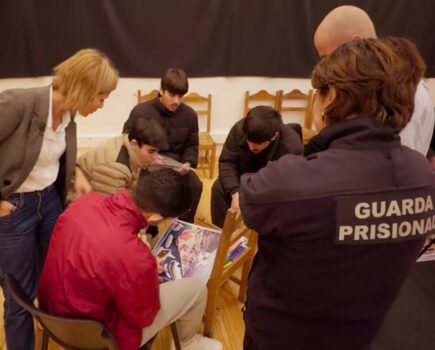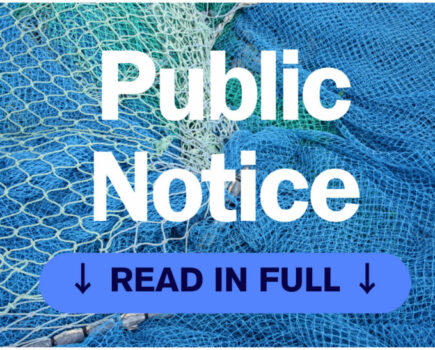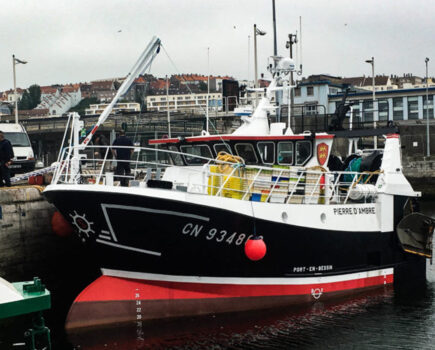Reply to Mrs Madeleine Moon, MP for Bridgend
On 3 November, 2016, Fishing News published Mrs Madeleine Moon’s reply to our open letter.
Although a few months have elapsed, we have been carefully considering our reply and will now respond to Mrs Moon’s letter.
The whole point of our Open Letter regarding the RSA debate in the House of Commons was that we felt the general image of gill netting (in this case specific to bass) was being deliberately and sometimes obtusely misrepresented, especially by the proponents of the angling/sports fish lobby (Angling Trust, Bass Action Sportsfishing Society-BASS) and their sustained demonisation of inshore netting. They appear not to take into consideration the diversity of the various gillnet practices and seasonal, regional and local variations in method and deployment; important points which are often ignored.
Mesh size of gill nets are of paramount importance to the size selectivity of the target species. We still maintain that gill nets have an important role within the inshore fisheries like bass and mullet (the latter which would not be realistically commercially fishable by hook and line)
Unfortunately, Mrs Moon has refused to amend what we consider to be casual comments made in the House of Commons regarding gill nets, that we contend were misleading. She states instead that she will ‘correct our misleading claims’ and ‘redouble her efforts’. It is clear to we fishermen that she is selectively interested in the issues for which she has been lobbied.
Her response to our Open letter is clearly backed by the angling lobby against gill nets. Furthermore, she and they are obviously using the current bass stock situation to further their own agenda. This agenda is not just about conservation of bass stocks, but the creation of an exclusive recreational hook-and-line-only fishery for bass to the disadvantage of registered, licensed, small boat fishermen who may use gill nets as part of their inshore fishing repertoire.
She deflects our point about gill net selectivity by resorting to distressing photos of seals (attached to her letter) caught in nets. Mrs Moon may consider the use of such startling imagery as effective propaganda with which to negatively brand all fishermen using nets, but we must be at pains to point out that there has never been a single reported incident of seals being caught in nets by the Warsash Fishermen.
We are not saying it cannot happen in some fisheries using certain gill net types; fishing with nets is not without its drawbacks; it is not a perfect system. But fishermen are working hard and liaising with IFCAs to minimise its occurrence. It certainly doesn’t happen in the Solent where nets are often constantly attended, with short soak times and we doubt it is the ‘regular occurrence’ that Mrs Moon claims in fisheries within Poole Harbour. Mrs Moon can always check with SIFCA if she does not believe us or think we are being ‘misleading’.
What we would ask, however, is this: is it merely coincidence that the issues Mrs Moon chooses to be outraged about happen to coincide with the conservation issues championed by the angling lobby as a means to curtail our activities in favour of their own sport? We think not.
If it were so, then Mrs Moon would be calling on angling to be banned outright, especially in the light of a damning Environment Agency report which concluded that out of 8,000 reports of swans in trouble per year, roughly 3,000 were angling-related. This will only increase with the numbers of anglers increasing.
Please see the photo we have enclosed.
In 2014, BASS lead campaigner Nigel Horsman (who is on the Southern IFCA working group board) submitted a report to SIFCA regarding bass management measures.
In that report he states that ‘discards from gillnets depend mostly on mesh size and soak times. Mesh size makes them size selective so an appropriate increase in mesh size would prevent an increase in discards.’ Mrs Moon needs to take note of this because, since the new stipulation for MLS 42cm in 2015, fishermen had been complying with that new conservation reference size by upgrading their net mesh size.
Yet, as well as this, Mr Horsman and his society are advocating quote ‘a total ban on netting within 300m of the shoreline and a total ban on netting within the bass nursery areas’. See here.
There is a contradiction in terms here: they are saying that they encourage and applaud fishermen to increase mesh sizes to suit the new bass MLS 42cm (which does achieve selectivity and near zero discards) but on the other hand they are lobbying to ban inshore netting! This would render our efforts to increase mesh sizes to suit the new MLS totally in vain. In addition, other inshore net fisheries like Poole Harbour would be made illegal for all fish species, not just bass.
This is a totally unacceptable proposal and a stealthfully vindictive attack on inshore netsmen who have a licensed mandate and are permitted to supply fish for the nation. The recreational/pleasure/sport sector has no licensed mandate of such importance.
Also, if the SIFCA (with which Mr Horsman is involved) does not consider mullet netting in the bass nursery areas (like Poole Harbour and Southampton Water) to be a problem with bass by-catch – as well evidenced by years of fishing/checking of catch by the authorities – why are BASS/Angling Federation lobbying for a ban on netting within the nursery areas at all?
It is this stealthful, extremist approach to ban all netting inshore that we strongly oppose and regard as totally unnecessary and unacceptable. Mrs Moon hysterically adopts this same extremist style without considering the views of the fishermen who are actually licensed to do the job.
There is plenty of evidence that anglers themselves are not whiter than white. As we pointed out in our last letter, regarding deep-set hooking of juvenile bass with small hooks and post-hooking mortality rates, a point that is often glossed over. Mrs Moon chose not to respond to that point. There are also the many historical anecdotal cases of significant quantities of bass being landed/illegally sold by angling boats and the increasing depletion of peeler crab by anglers in inshore areas where nursery bass and other fish feed.
Now, we will address some of the other points in Mrs Moon’s reply.
- Mrs Moon says that ‘gillnetting has increased’.
In our area licensed use has decreased due to the dwindling fleet. Our small boats that have used nets for any length of time have not increased their carrying capacity. One of our fishermen only carries one small net bin containing 400m, enough to eke out a living without sinking his vessel. Illegal use of gillnets by un-licensed individuals however, may have increased. When one of our fishermen from Warsash posted a comment on the BASS website that the incidence of gillnetting in the Solent was low and that he could prove it, it was quickly removed by BASS moderators within hours. Apparently, they would rather not their narrative be questioned or contradicted.
- Mrs Moon says that because we claim our under-10 fleet is ‘lower impact and only able to deploy small lengths of net’, that we (Warsash Fishermen) are implying that our ‘impact is negligible’.
She disputes that we can only work short lengths of net, saying that ‘inshore boats are quite capable of deploying many kilometres of nets’, quoting the NFFO to back herself up.
The NFFO’s point was that there is a fraction of the under-10 fleet that has more catching power. But that does not describe the greater number of small inshore boats. Mrs Moon is quite aware of the vessel size we were referring to, and the limited net carrying capacity. We made that very clear on page 4 of our Open Letter (in bold) in that we are the smaller vessels of the inshore fleet. She appears to know very little about the limitations of small 16-20′ open fishing boats. If she doesn’t believe us, she can come down and see for herself.
Furthermore, we are not using nets at all times throughout the year. A fact Mrs Moon would have clearly realised if she had thoroughly scrutinised our ‘Analysis of the RSA debate’.
- Mrs Moon says that mono net is cheap and easily available and that we didn’t mention ‘hanging ratios’ for nets.
For a small-scale net fisherman, gill nets are not that cheap actually. 400 metres of gillnet costing £500 (plus the cost of the bin) is a significant outlay for a little boat, considering that the netting will have to be replaced every 2-3 years.
- Net hanging ratios: Mrs Moon and her advisors reveal just how ignorant they are about how our bass nets are rigged and what constitutes a ‘tangle net’. It is common historical practice for net manufacturers to rig bass nets by ‘a-half’. That is not considered to be a tangle net. Mesh size will still be the dominant factor in catching power. How they are rigged will depend on which fish is being targeted. How they are set, will influence selectivity to a degree. Bottom-set nets have had selectivity proved in DEFRA trials for bass and mesh sizes suggested accordingly – all these were set by ‘a half’, with mesh sizes tested from 90mm to 120mm. (See page 6 of this report).
- Mrs Moon states that a vessel using 100mm mesh caught 680 bass of which 82% were below 42cm. She has not made clear what situation she was referring to. Was it a set-net targeting bass/or a drift net; a trial to determine mesh size for the new 42cm MLS or a net for another target species? In last year’s bass measures (2016), DEFRA did not stipulate the mesh size for bass; they left it to the fishermen to decide which mesh size to use. They could have done so – instead of stopping netting completely this year – but again, they did not.
In 2016, we at Warsash started to experiment with different sizes (at extra cost to ourselves) to determine what mesh size to use. The Hastings fishermen have also attempted to explain these issues of net selectivity in the past and how selectivity can be affected by methods of deployment: (see here).
Mrs Moon asks how we can avoid catching small bass when fishing for mullet when the MLS for mullet is only 30cm?
In our previous correspondence we have suggested MPs like Mrs Moon and her advisors should ‘re-educate themselves on the subject of gillnets’ rather than relying on rumour, hearsay and guesswork from the angling lobby.
Mrs Moon assumes that because the minimum landing size (MLS) for mullet is 30cm we would be targeting mullet of this size. Not so, Mrs Moon. All specialist mullet netsmen would ridicule you for that suggestion. The mesh size would have to be so small that it would catch mullet of 30cm together with unwanted, small fish, including the very species considered under threat: juvenile bass. In addition, such a small mesh size would not be appropriate to gill a more marketable, larger mullet.
The mesh size we use for mullet catches a much larger fish than 30cm in the targeted inshore fishery, similar to the mullet fishery in Poole Harbour, with very short soak times, and where the nets are constantly attended. This has taken place for generations, with hardly any undersized bass by-catch issues. The Salcombe fishermen have also reported this. (See Fishing News, 14 July 2016: ‘Salcombe netsmen fight possible estuary netting ban)’. Our Southern IFCA know this also, so Mrs Moon can always check with them. Mr Horsman of BASS must also know this, as he is on the SIFCA working group board.
So it should now be clearly obvious from our questioning of Mrs Moon’s response that there is more to the subject of gillnet use than may first be apparent to the casual onlooker. It is local knowledge, experience and the details of handling nets that are also important factors in how gill nets fish. Members of the public, angling lobbyists and MPs like Mrs Moon have revealed their actual lack of knowledge and deliberate avoidance to familiarise themselves with this information. They do not want to hear anything that contradicts the anti-net hysteria narrative built up over many years.
There are other small-scale gillnet fisheries which are not considered to be exploited beyond sustainable limits. These fisheries are informed by scientific evaluation of the stock and are not being stopped just because nets are involved. Nets are part of the inshore fisherman’s repertoire and are used for a whole variety of fish, not just bass.
Mrs Moon must surely realise that gill netting (and trawling) play an important role in the effective supply of fish as a food resource. Not all fish can be readily supplied by hook and line. Furthermore, some open inshore boats are not suited to take full advantage of a wholly hook-and-line fishery for bass. Some areas are more suited to this style of fishing than others, like Portland Race for example. It is the absence of this kind of common sense reasoning which we also find very worrying.
The point we made to our MP, Suella Fernandes, was that damage to the bass stocks had been done over many years by large-scale depletion, especially on spring spawning aggregations with no effective quota measures. Now the stocks are considered to be in trouble, that situation is being taken advantage of to further limit our fishing capabilities.
In conclusion, it is our expectation that the small-scale net fisheries for bass will resume, in line with sustainability-guided catch limitations similar to other inshore net fisheries – once the bass stock has recovered.
If this fails to happen, then it will be clear to us that the latest EU measures were not introduced just for the sake of conservation, but to appease angling lobbyists who have persuaded government ministers to have gill nets banned outright, in a conspiracy to re-designate bass for RSA/line-caught all along.
Thanks for the seal-caught-in-nets picture Madeleine! Here’s one for your scrapbook from us… ‘catch and release’.

Happy angling.
Sincerely
The Warsash Fishermen’s Group
Copies to: Madeleine Moon, MP for Bridgend; George Eustice, MP, Minister of State; the Editor, Fishing News; National Federation of Fishermen’s Organisations (NFFO); Suella Fernandez, MP for Fareham, Hampshire; Andrea Leadsom, MP, Minister of State (DEFRA); New Under Ten Fishermen’s Association (NUTFA); Southern IFCA.







